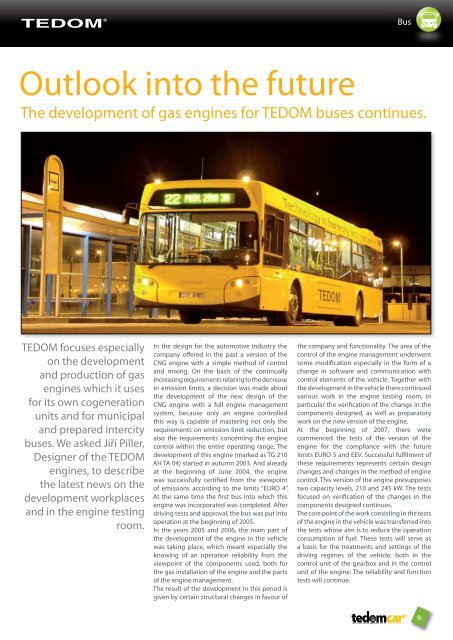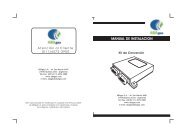Brochure - ABA Gas
Brochure - ABA Gas
Brochure - ABA Gas
Create successful ePaper yourself
Turn your PDF publications into a flip-book with our unique Google optimized e-Paper software.
Outlook into the future<br />
The development of gas engines for TEDOM buses continues.<br />
TEDOM focuses especially<br />
on the development<br />
and production of gas<br />
engines which it uses<br />
for its own cogeneration<br />
units and for municipal<br />
and prepared intercity<br />
buses. We asked Jiří Piller,<br />
Designer of the TEDOM<br />
engines, to describe<br />
the latest news on the<br />
development workplaces<br />
and in the engine testing<br />
room.<br />
In the design for the automotive industry the<br />
company offered in the past a version of the<br />
CNG engine with a simple method of control<br />
and mixing. On the basis of the continually<br />
increasing requirements relating to the decrease<br />
in emission limits, a decision was made about<br />
the development of the new design of the<br />
CNG engine with a full engine management<br />
system, because only an engine controlled<br />
this way is capable of mastering not only the<br />
requirements on emission limit reduction, but<br />
also the requirements concerning the engine<br />
control within the entire operating range. The<br />
development of this engine (marked as TG 210<br />
AH TA 04) started in autumn 2003. And already<br />
at the beginning of June 2004, the engine<br />
was successfully certified from the viewpoint<br />
of emissions according to the limits “EURO 4”.<br />
At the same time the first bus into which this<br />
engine was incorporated was completed. After<br />
driving tests and approval, the bus was put into<br />
operation at the beginning of 2005.<br />
In the years 2005 and 2006, the main part of<br />
the development of the engine in the vehicle<br />
was taking place, which meant especially the<br />
knowing of an operation reliability from the<br />
viewpoint of the components used, both for<br />
the gas installation of the engine and the parts<br />
of the engine management.<br />
The result of the development in this period is<br />
given by certain structural changes in favour of<br />
Bus<br />
the company and functionality. The area of the<br />
control of the engine management underwent<br />
some modification especially in the form of a<br />
change in software and communication with<br />
control elements of the vehicle. Together with<br />
the development in the vehicle there continued<br />
various work in the engine testing room, in<br />
particular the verification of the change in the<br />
components designed, as well as preparatory<br />
work on the new version of the engine.<br />
At the beginning of 2007, there were<br />
commenced the tests of the version of the<br />
engine for the compliance with the future<br />
limits EURO 5 and EEV. Successful fulfilment of<br />
these requirements represents certain design<br />
changes and changes in the method of engine<br />
control. This version of the engine presupposes<br />
two capacity levels, 210 and 245 kW. The tests<br />
focused on verification of the changes in the<br />
components designed continues.<br />
The core point of the work consisting in the tests<br />
of the engine in the vehicle was transferred into<br />
the tests whose aim is to reduce the operation<br />
consumption of fuel. These tests will serve as<br />
a basis for the treatments and settings of the<br />
driving regimes of the vehicle, both in the<br />
control unit of the gearbox and in the control<br />
unit of the engine. The reliability and function<br />
tests will continue.<br />
9.



